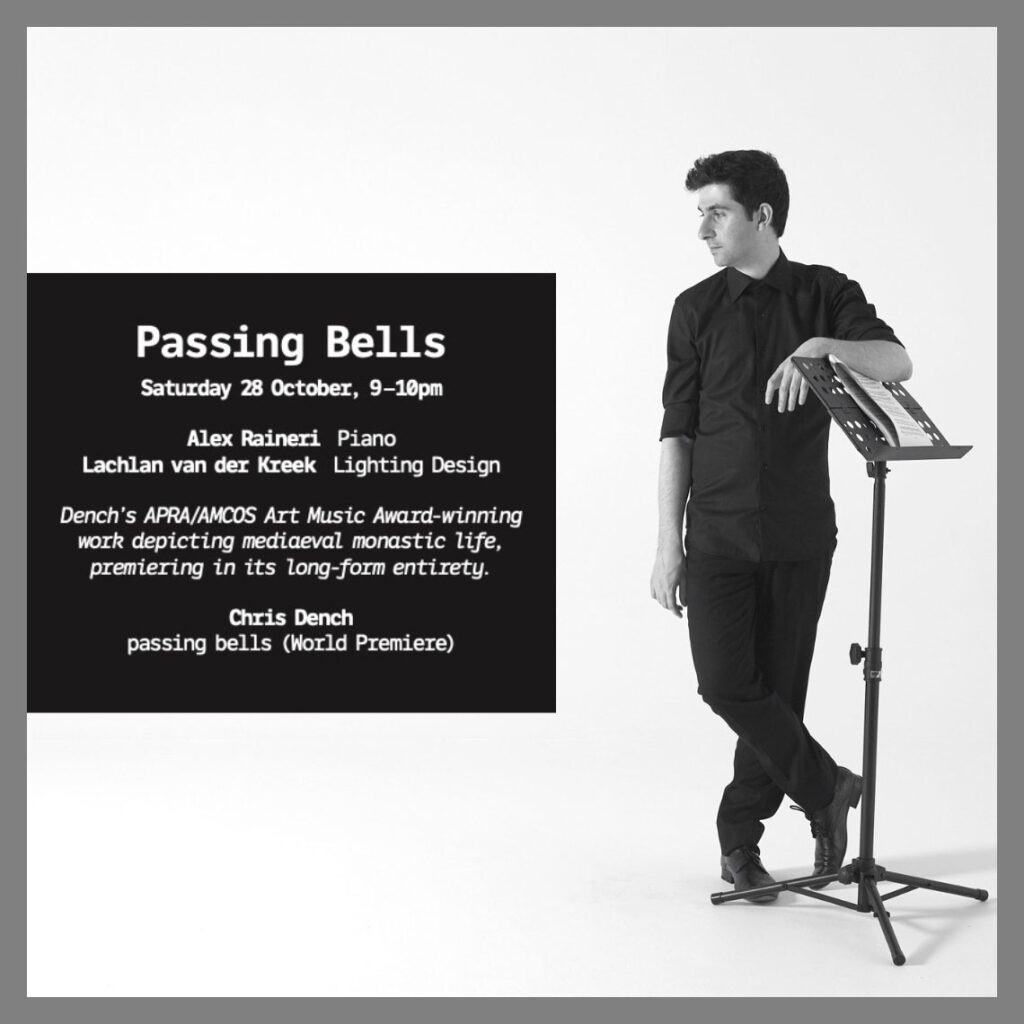Alex Raineri world premieres the complete passing bells in Brisbane on October 28!

On October 28 Alex Raineri will present, for the first time, the entire passing bells multi-panel arch, from ‘midnight to midnight’. The score proposes a lighting scheme reflecting the piece’s diurnal structure, and Alex has chosen to adopt this for his World Premiere. I started passing bells almost twenty years ago, shortly after moving to Newcastle in NSW. That move was the beginning of my life with Kate Sullivan, my wife, and so the piece is coextant with our partnership. Coincidence it may be, but to me there is a singular appropriateness that Alex Raineri’s world première of the piece should take place three days after our twentieth anniversary.
For those interested but unable to attend, the concert will be filmed, and in a future blog I will provide a link to that audiovisual record.
When sitting down to nut out a new piece I am always cognisant of the truth voiced by artist Grayson Perry: “[Our] job is to make meaning. To make meaning in a meaningless world. Ceremonies don’t just fall from the sky, we make them all up”. On the whole, it is my preference to invent new ceremonies/structures from scratch, as most of our familiar ceremonial structures, from the Mass to marriage, have their roots in Christian and/or Imperial hegemony, and I have no desire to reflect them in my work. Reading Barbara Tuchman’s A Distant Mirror: the Calamitous 14th Century, however, I was struck by her thesis that the times she describes mirror our own, and slowly formed an idea of how to import the religion-suffused, every-day-the-same, synchronic experience of mediaeval being into a contemporary structure.
The result, passing bells, is a composite work, then, adopting a characteristically mediaeval polyptych panel form to link the Middle Ages with our times. Over about 40 minutes it ostensibly covers twenty-four hours in the cyclic rhythm of mediaeval life, from midnight through to midnight. The opening panel, Vigils, is intended to recall the quiet intensity of the Great Silence of overnight monastic Prayer Watches: the Religious earnestly attempting communion with their fictional god. Vigils leads directly into Day, structured following the seven Benedictine Prayer Hours, or Offices, of the mediaeval day, from Lauds at Dawn, to Compline in the evening. Bells obsessively toll throughout Day, expressive of the permanent anxiety of coexistence with the Black Death. Whereas Day intersperses the bells with the frantic pursuit of the everyday, the following Night panel presents them in a landscape of silence, the empty, eventless darkness of the evening hours. As Barbara Tuchman reminds us, “the passing bells rang all day and all night…” The work ends with a brief postscript, named after Catullus: …nox est perpetua una dormienda, which Raleigh rendered as ‘The sun may set and rise,/ But we, contrariwise,/ Sleep, after our short light,/ One everlasting night’. After the dark Night of the soul, this is the long, pagan, sleep of oblivion. Like life, the work is structured as a myriad (well, 122) tiny capsules of experience, some fleeting and lightweight and others of more moment. If they cohere, it is because each belongs to just one of a set of affective threads and their associated harmonies—seven in day and seven in night. Gregorian chant fragments adapted from Usquequo Domine, oblivisceris me in finem / How long, O Lord, wilt thou forget me unto the end? (Psalm 12/13) act as a glue, providing a gestural unity to the various melodic threads.
Not irrelevantly, there is a pair of homages to Orwell in the score: “…the clocks were striking thirteen”.
When I started passing bells in 2004 the events of 9/11 still hung heavily on us all. Then the completion of the piece coincided with the appearance of the COVID-19 ‘plague’—an eerily apposite bookending. And as I worked on the closing pages of the piece I heard the sad news that my mother, Audrey Dench, had died aged 96, and the work is now dedicated to her memory.
For all that intense imagery, the work is also an abstract mosaic of stitched-together material, and even the bell-sound provenance and Gregorian chant borrowings are subsumed into a carefully-controlled complementary architecture. How you listen to it will depend on your preference: for narrative or for structural logic. …Or both, of course. Unsurprisingly, the dominant flavour of the piece is melancholy.
The first section of the piece, passing bells: night was premièred – by Marilyn Nonken – in 2004, under the auspices of ELISION; it even found its way onto my beyond status geometry CD from Tzadik. In 2018 I decided, partly in response to the encouragement of my colleague, webmeister and engraver, Andrew Bernard, to complete the entire arch of the passing bells structure; Alex Raineri then suggested that I finish passing bells: day for his December 2019 Brisbane Festival closing concert—a request I was pleased to satisfy. That performance garnered the work the APRA/AMCOS Chamber Music Work of the Year Award for 2020.